It is a common debate among cyclists (and mechanics) which is the best bicycle bearing grease – for use in hub, or steerer, brake pivot etc. bearings. Some swear by the old “axle grease” that “… my grandfather / father used …” Others recommend silicone, Teflon, graphite grease and so on. This post explains important characteristics of various greases in terms of lubricating bicycle bearings.
First there will be a few words about basic construction of bicycle bearings, lubrication requirements and types of loads that bicycle bearings take. Type of bearings and loads it takes are an important factor when selecting lubricants. Then basic characteristics of greases will be explained – in general, with standards for labelling greases explained (so that label can be understood when shopping for grease). Finally, an overview of most commercial greases types available, with advantages and disadvantages for bicycle bearing lubrication use. For simple, non-technical recommendations, look at this post: The best bicycle bearings grease. Related posts are explaininig: Bicycle hub overhaul procedure and Bicycle bearing types and designs.
Note: for mounting things (bolts, seatposts, handlebars etc.) – that is for things that are not made to slide when used, many people use grease, while it is preferable to use anti-seize / mounting pastes (as explained in that linked article). This post deals with greases in terms of lubrication primarily.
0. Disclaimer
All the information provided in this article, as well as on all of my websites, is to be taken as: “to the best of my knowledge”, or “as far as I know”. I have consulted experts of various fields (and still do), including mechanical engineers, especially when writing on this, rather “can-of-worms” topic, and info provided on my websites does agree with my practical experience, but it still is my opinion – based on my knowledge, education and experience. Different people, including experts, have different experiences and, often, different opinions. I’m sure there are, and will be, people who completely, or partially disagree. Even more often – there is and will be data (experiments, statistics, publications etc.) that might contradict, or seem to contradict my work when read/interpreted by a non expert. All of this is normal and to be expected.
People’s reactions to this particular article seem to range from taking it as a gospel, to taking it as blasphemy. Still – it is no more, and no less than: “what I have learned (through theory and practice) so far”. And, like all the other articles, it gets updated as new knowledge is acquired.
1. The loads bicycle bearings take
Bicycle bearings, whether on wheels, cranks, or fork, are usually ball bearings, i.e. they consist of balls, trapped between two races. These bearings are almost never made to be easily re-lubricated from the outside, without disassembling them, so frequent lubrication would take a lot of time.
Since bikes are ridden outside, bearing lubricant needs to keep dirt and water from entering. It should be resistant to being washed off with water, prevent corrosion, while operating temperature ranges from as cold as -20 °C for winter use (though some cyclists are even more extreme), to about 100 °C for bearings of bikes left in hot summer sun, then ridden.
Those bearings need to cope with the load of under 200 kilograms (usually). The load is dynamic, so that impacts can drastically change the volume. However, due to the low weight of a bicycle, only human strength of it’s rider, as well as the fact that a bicycle carries a maximum of two people (specially designed tandems), the forces that occur and bearing loads are relatively small compared to similar in cars, motorcycles, or industrial machinery.
Another important thing is the speed. When a bicycle is ridden around 30 km/h, wheels turn about 250 times per minute (250 rpm). Pedals are rarely turning faster than 100 revolutions per minute, while the steerer bearings rpm is much lower. Also, the distances traveled by bearing balls are relatively small due to the small diameter shaft. When the tyre travels around one meter, hub bearings cover a distance of under 10 centimeters.
So the weight and the speed with which bicycle bearings are loaded are quite modest. While frequent re-lubrication is not practical.
2. Oil as a bearing lubricant
It is quite popular, especially among road bike racers, to pour oil into the bearings (particularly the hubs). The logic is that oil generates much less rolling resistance compared to grease, because it is much “thinner”, more liquid. For the same reason, the oil leaks out easier and is less efficient at keeping dust and water from penetrating the bearing.
It should also be taken into consideration that the design of a bicycle wheel with a hub in the middle makes the lever by which the force is applied to the hub so large that the drag that hubs eventually produce is practically negligible. Especially when comparing the drag of oiled versus the drag produced by properly greased hubs. Even when each second counts, there are lots of other places where the time can be saved (both on the bike itself, as well as with the equipment), while the hubs should be the last thing to experiment on. Of course, everyone chooses by themselves, for themselves, but if hubs are lubricated with oil, it should be noted that this should be repeated every week, or every 500 kilometers ridden – whichever of the of the two comes first.
3. Greases
Before explaining grease types and properties, it needs to be said that there is no such thing as the best grease. There is only optimal choice grease. Optimal as best satisfying all the important criteria. For example: if a grease has best characteristics for lubricating bicycle bearings, but is outrageously expensive, it will not be an optimal choice as long as there is a significantly cheaper grease that has sufficiently good characteristics for the application.
3.1. Attributes that bicycle bearing grease should have
Greases are semi-solid lubricants, used when oils, or liquid lubricants are not appropriate. Either because of higher costs, or for technical reasons. As it was briefly mentioned in previous paragraph, bicycle bearing grease should fulfill the following criteria:
Criterion 1 – Good functioning in a temperature range of -20 to +80 °C. Greases shouldn’t become too hard at the lower, nor become liquid at higher use temperatures. As will be explained, greases that fulfil this criteria need to have a dropping point of at least +100 °C (for hot climates better +120 °C), and the lowest operating temperature (“use temperature” in the remainder of this text) of at least -20 (for cold climate cycling preferably -30 °C).
Criterion 2 – Good corrosion protection and oxidation resistance
Criterion 3 – Good resistance to water wash out and to water and dirt contamination. Per standard ISO 6743-9 at least level E, or better of water resistance. Bicycle bearings are usually not submerged into water, nor is water sprayed on them under pressure. That is why they don’t require water protection levels as some other bearings, e.g. boat trailer wheel bearings.
Criterion 4 – Compatibility with (plastic, or rubber) dusters that some bicycle bearings have.
Criterion 5 – Keeping stable structure and hardness for a longer period of exploitation. Re-lubing bicycle bearings more often than once a year is highly impractical.
Criterion 6 – It should pass 4 ball weld test with weld load over 1000 N.
Criterion 7 – Low price. Out of two greases that both satisfy previously noted criteria, it makes sense to choose the cheaper one. It makes no sense for lubrication, in a medium term, to cost more than replacement of a bearing.
Listed criteria will be used in the remainder of this post note by their numbers. Crit. 1, crit. 2 and so on.
3.2. Grease types division
Most greases (exceptions will be noted and explained) consist of three basic parts:
- Base oil (70 – 90%) – that actually lubricates
- Thickener (3 – 30%) – that keeps the grease hard, holding base oil in suspension and preventing it from leaking out
- Additives (0 – 10%) – that increase beneficial and suppress unwanted attributes of used base oils and thickeners
Even though thickener is what most often gives a grease it’s name (e.g. lithium grease, calcium grease etc), base oil is what does the actual lubrication and usually makes for over 80% of the grease volume. Greases can be divided according to the following criteria:
- 3.2.1. according to base oil type
- 3.2.2. according to thickener type
- 3.2.3. according to intended use area
- 3.2.4. according to exploitation temperatures range
- 3.2.5. according to capability to bear high loads, extreme pressures
Some division criteria are “overlapping”, i.e. different types of base oil can be used with one type of thickener, in order to achieve different grease characteristics. For example, lithium soap based thickener can be used with either mineral, or synthetic base oils to achieve different grease characteristics. In addition to that, in either of the mentioned combinations, another additive can be combined, like molybdenum disulfide for example, in order (in this case) to improve grease’s resistance to extreme pressures, or (extremely) heavy loads.
Before grease divisions are given in detail, picture 1 might seem a bit unclear, but it will help for all the data to fall into place. Thickener type is what practically defines a grease type.
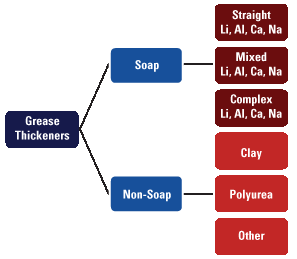
Grease types graph
3.2.1. Base oil type division
- Mineral greases. With mineral base oils. Mostly used.
- Synthetic greases. With synthetic base oils. Usually have properties superior to other comparable greases. With a (significantly) higher price.
- Biodegradable greases. Usually made with beet oil. Used where quick biodegradation of lubricant is needed
3.2.2. Thickener type division
- Soap greases. Soaps are usually made by saponification of fatty acids with hydroxides of various metals – aluminium, calcium, sodium, barium.
- Complex (soap) greases. These greases are more of a subgroup of soap greases when dividing according to thickener type. Soaps with long fibres are resistant to mechanical loads, but don’t hold oil in suspension very well, while soaps with short fibres hold oil in suspension well, but don’t take mechanical loads as well. That is why complex greases are made as a combination of (the same metal) soaps that hold oil in suspension well, and soaps that have good resistance to mechanical loads.
- Mixed soap greases. Similar to complex greases, except two different metal hydroxides are used, usually lithium-calcium, or sodium-aluminium. They have superior characteristics to other soap greases (even complex ones), but their price is higher, they are less easily available and are seldom used.
- Non-soap greases. They don’t contain soaps, nor oil that soaps hold in suspension. Non-organic silicone, or bentonite, or organic polyurea.
Table 1 shows grease division and characteristics according to thickener type. Note that maximal use temperature is significantly lower than dropping point temperature (at which grease becomes practically a dripping oil).
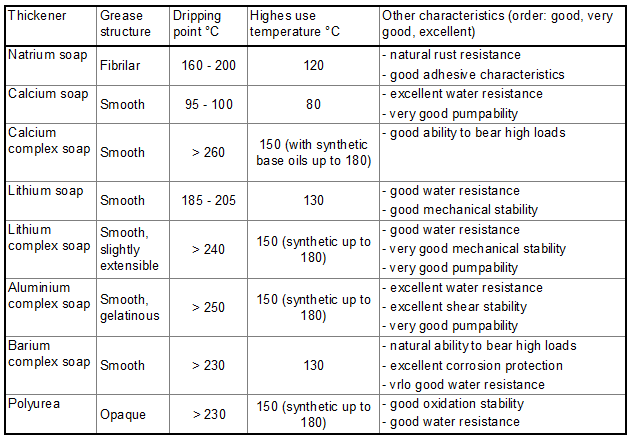
Grease characteristics according to thickener type
3.2.3. Intended use area division
- Universal (general purpose) greases
- Special greases with added solid lubricants, such as graphite, or molybenum disulfide (MoS2). Usually used for high load and pressure bearing greases. Special additives, when they are not needed, in addition to increasing the price, can have a negative affect on grease properties for the intended use!
- Greases for roller and plain (slide) bearings.
- Sprocket greases
3.2.4. Exploitation temperature range division
- Low temperature greases – for working temperatures (well) below -20 °C.
- Normal temperature greases – for temperatures from -20 °C to +100 °C.
- High temperature greases – for working temperatures that in a prolonged period of time stay above +100 °C (often even +200, or over +300 °C in some cases).
3.2.5. High load and pressure bearing capability division
- Greases for normal loads and pressures
- Greases that can bear high loads and pressures, i.e. with EP (Extreme Pressure) additives. Just like special additives, greases with EP additives shouldn’t be used when EP characteristics are not required.
3.3. Grease labeling according to standards
3.3.1. Grease consistence (hardness) labeling according to NLGI standard
Standard for labeling grease consistency is established by American non-profit, independent NLGI (National Lubricating Grease Institute) organization.
Consistency (hardness) is measured with a cone, by methods standardized under ASTM 217 IP 50, or DIN 51804, part 1. Measuring unit represents depth the measuring cone enters the tested grease. Testing procedure is shown in the picture 2 below.
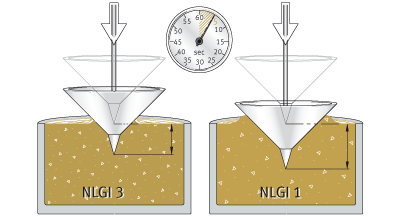
NLGI testing and measuring
In plain English, grease is held at a temperature of 25 °C. It is well meshed (standard prescribes 60 meshing cycles). Then the surface is put in a container, top surface is smoothed over, and a cone shaped plunger is slowly placed from the top to dig into the grease with it’s own weight. Diameter of the hole imprinted by the cone is then measured in tenths of a millimeter. Standard is shown in table 2.
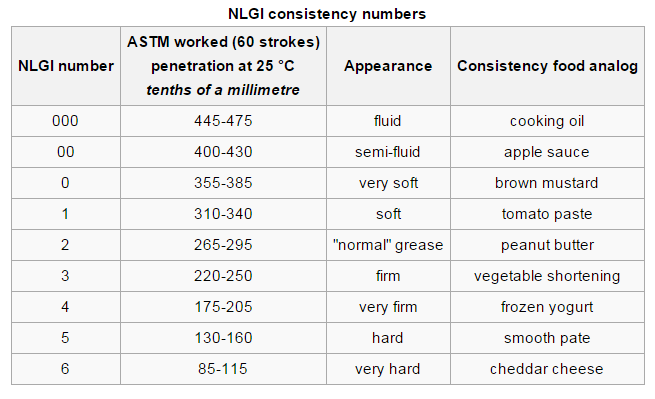
3.3.2. Grease labeling according to ISO standard
According to international standard ISO 6743-9, greases are divided per intended use conditions. Example of an ISO label:
ISO 6743-9: ISO-L-XCCHA 2
Meaning of each letter is given in table 3.
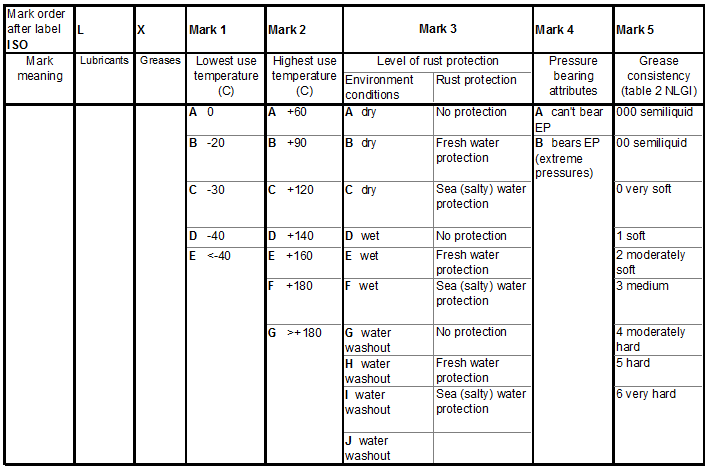
Grease labeling according to ISO standard
3.3.3. Grease labeling according to DIN standard
German DIN 51 502 standard for labeling greases, unlike ISO, with legendary German precision and efficiency sorts greases according to base oil types, additives etc, so there can be no confusion when choosing the appropriate grease for a given application. 🙂 Example of a DIN label:
DIN 51502: K2 K-30
Meaning of each letter is given in the tables 4 and 5.
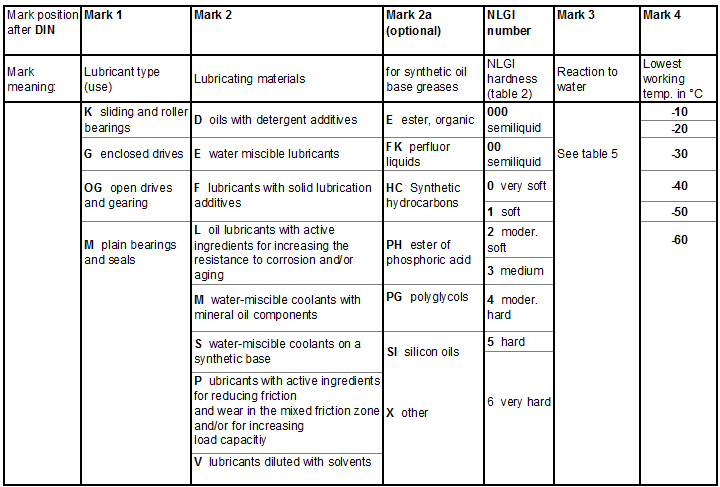
Grease labeling according to DIN standard
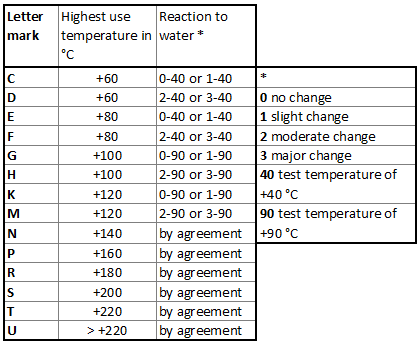
Reaction to water according to DIN standard
Note:
Mark 2 in table 4 is used only if a grease has some of the ingredients/properties listed in that column – otherwise, the mark is omitted.
See the “Bike greases questions” discussion on the BikeGremlin forum for a bit more details on this.
4. Solid (state) lubricants
Solid lubricant is a material used as a dust, or a thin film layer, to protect adjacent sliding surfaces and reduce wear and friction during their relative movement. In practice, solid lubricants are often suspended in oils, or added to greases (see 3.2.3. special greases).
Solid lubricants are used in extremely high, or low temperatures, extreme pressures, sudden and great variations of loads, hardly accessible parts, parts that can not be regularly re-lubed, corrosive environments, vacuums, or high speed moving parts. Solid lubricants are also practical in conditions where dirt, dust, or sand occur in amounts that could cause problems, because they aren’t as sticky to collect much dirt. They can also fill in gaps between partially worn parts, prolonging the replacement period. Solid lubricants are also used to ensure good running in, instead of wear of recently machined metal surfaces.
4.1. Solid lubricants division
Solid lubricant groups most commonly used are lamellar solids, polymers and soft metal films. In addition to noted, there are some more, better to call them subgroups of solid lubricants, such as multipurpose solid lubricants, combinations of ceramics and solid lubricants, materials made of glass etc. Those lubricants are usually used for extreme and special conditions and temperatures over 1000 °C, to they will not be explained in a post that is about bicycle bearing greases.
4.1.1. Lamellar solids
Graphite. Has low friction coefficient, but use (and maximal use temperature) is limited because in order to minimize friction, it needs to absorb some moisture. It also has a high electrical potential of +25 V, so can cause strong galvanic corrosion of copper and stainless steel alloys in salty water. In practice it is used for temperatures up to 600 °C.
Molybdenum disulfide (MoS2). Like graphite, has low friction coefficient, but doesn’t need to absorb moisture to achieve it (moisture with MoS2 can even somewhat increase friction). Has higher load bearing capabilities than graphite. In environment with oxygen, it can be used for temperatures under 400 °C, while in a non-oxidant environment it is stable up to 1100 °C.
4.1.2. Polymers
Polymers are used as thin lubricating films, as self-lubricating materials for elements manufacturing and as a bonding material for lamellar solids. The most famous polymer solid lubricants are tetrafluoroethylene (TFE), a gas without colour and smell, which with polymerization gives polytetrafluoroethylene (PTFE). PTFE is registered under the (often used) name of Teflon, by DuPont company. One of the most slippery materials on the planet, with a friction coefficient similar to wet ice sliding over wet ice. 🙂
Main advantages of PTFE are low friction coefficient and wide range of working temperatures, from -200 °C to +250 °C. Disadvantages are a higher price and inability to bear high loads.
4.1.3. Soft metal films
Many soft metals, like copper, silver, gold, zinc, lead etc. have low shear resistance and can be used as a lubricant, put in a thin layer over sliding hard surfaces. Soft metal films are useful for tempereatures up to 1000 °C, but are less often used nowadays.
4.2. Comparative review of solid lubricants
Table 6 gives a comparative overview of some commonly used solid lubricants. As can be seen, MoS2 satisfies most criteria and that is why it’s most commonly used, often as an additive to greases.
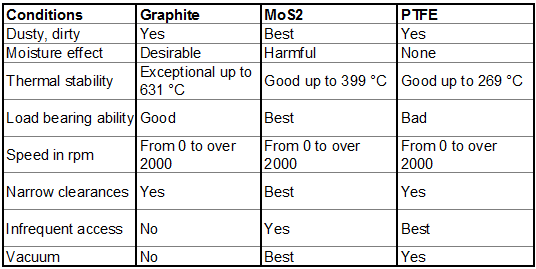
Comparative review of solid lubricants characteristics
5. List of various greases available on the market, with usual characteristics
Having explained grease type division in paragraph 3, this paragraph explains some produced and available greases, as combinations of thickeners, base oils and (sometimes) additives. As will be seen, thickener type is usually what gives a grease it’s name, with additives (especially in case of solid lubricants) noted as an appendix.
“Usual characteristics” in the heading is written because various manufacturers (and concrete grease models) use various ingredient qualities, so final product characteristics may vary. Concrete characteristics a finished grease possesses is usually written on the label, either in the form of a marketing slogan, or (more reliably) by noting DIN and/or ISO standard that a grease complies with. Characteristics like lowest and highest use temperature, water washout resistance etc.
5.1. Calcium greases
They are widely used and available. Basic calcium greases have low price. Calcium thickener provides the grease with an excellent water resistance. These greases have a relatively narrow working temperature range. I.e. if bicycle is ridden below -20 °C, or it stays in hot summer sun before riding (over +35 °C), then they are not the best choice.
Of important criteria listed in paragraph 3.1. these greases only have problems with fulfilling Crit. 1. (for extreme conditions of bicycle use), while Crit. 3. is probably best satisfied of all the other grease types, except some enormously expensive ones.
5.1.1. Complex calcium greases
Somewhat improved characteristics than ordinary calcium greases. They usually have a higher maximal working temperature (check the label) so they are good for extreme summer heats.
5.1.2. Axle grease
Marketing name for basic, very cheap calcium grease. Slightly lower working temperature range than “ordinary” calcium grease, so not best used for bicycle bearings, but it will do in a pinch.
5.1.3. Marine grease
Grease used for (and marketed as) boat trailer wheel bearing lubrication. Bearings that need to be submerged into sea water when boats are put into the sea. Very good corrosion and water washout resistance. Use temperature range is similar to ordinary calcium greases (if it is complex, then like complex calcium greases). Relatively low price (similar to calcium, or complex calcium greases).
5.2. Lithium greases
Most widely used grease type. Widely available, at a low price. Fulfills all the criteria a bicycle bearing grease should satisfy. Water and rust resistance is not as good as that of calcium greases, but it is more than good enough for bicycle bearing application. Wider use temperature range than similar calcium greases. In case of high quality synthetic base oils, temperature range is even greater, though this raises the price significantly, without much measurable benefits for use with bicycle bearings. Perhaps for extreme (-40 °C cold) uses.
5.2.1. Lithium complex greases
Somewhat wider use temperature range than ordinary lithium greases (completely irrelevant for bicycle bearing lubrication use). Usually have better resistance to corrosion and water washout, similar to that of calcium greases.
5.2.2. Lithium complex EP greases
Same as lithium complex greases with EP (extreme pressure) additives. In fact, lithium complex greases are almost impossible to find manufactured without EP additives. These additives are not needed for bicycle bearing use. With greases, all that is not needed is usually harmful, but in this particular case, no measurable harm comes from the EP additives. They can increase corrosion of coloured metals and silver, but with steel bicycle bearings they are mostly harmless™. Better without them, but no problems with them.
5.3. Greases with graphite additive
Graphite is added to a grease as a solid lubricant, to improve extremely high load bearing characteristics. It is usually combined with calcium, or aluminium greases. Bearing extremely high loads is completely needless attribute for a bicycle bearing grease. You will needlessly pay more, with no measurable practical (or even theoretical) benefits.
5.4. Greases with molybdenum disulfide (MoS2) additive
Similarly to graphite additive greases (5.3.), excellent for high pressures and temperatures, with no negative impact on bicycle bearings. So lithium, or calcium greases with MoS2 won’t be bad for bicycle bearings, just needlessly expensive.
Exception where MoS2 greases are useful can be coaster hubs (hub brakes), where excellent heat resistance can help grease hold it’s own better. However, there are significantly cheaper, almost as good alternatives, like lithium complex greases.
5.5. Greases with Polytetrafluoroethylene (PTFE, “Teflon”) additive
PTFE is usually added to lithium grease. These greases differ from “teflon” greases, where PTFE is used as a thickener (with a synthetic base oil usually), not as an additive. PTFE improves grease performance with high speeds (measured in thousands of revolutions per minute). With greases for lubing bicycle bearings, PTFE as an additive needlessly increases grease price, but doesn’t harm (nor does it benefit) grease’s performance (not even in theory).
5.6. Polytetrafluoroethylene (PTFE, “Teflon”) greases
Greases where PTFE isn’t an additive, but a soap (or combination of PFTE/PFPE soaps), that keeps base oil in suspension. Harder to find, more expensive, less compatible to mixing with other commonly used greases (see paragraph 6.). Apart from that, characteristics are good for lubricating bicycle bearings.
5.7. Lithium-calcium complex greases
Combination of complex lithium and calcium soaps thickeners. With quality base oils these greases can be made to be superior to complex (even more so compared to ordinary) whether lithium, or calcium greases. They are less easily available and higher priced though – with no measurable benefits for use in bicycle bearings compared to quality lithium soap based greases.
5.8. “Silicone” greases (soap greases with silicone oils)
Silicone oils suspended in a soap of lithium, calcium, PTFE, fumed silica etc. Lithium soap based silicone greases have excellent properties for lubricating bicycle bearings, but are outrageously expensive. Because there are greases that cost a lot less, while being good enough, and because it makes no sense for lubrication after a few seasons to cost more than a new bearing, silicone greases are not an optimal choice.
5.9. Aluminium and aluminium complex greases
Not to be confused with aluminium anti seize pastes. Similar to lithium greases, with better water resistance (similar to calcium greases), but with a significantly higher price.
5.10. Sodium greases
Poor resistance to corrosion and water washout, so not good for lubricating bicycle bearings.
5.11. Barium and barium complex greases
Good water resistance, high dropping point, but limited low temperature use (slightly worse even than calcium greases). Very high price. Barium and many of it’s compounds are toxic!
5.12. Silica greases – non soap base greases
Greases without a soap. Thickener is amorphous fumed silica. Silica greases posses good oxidation resistance and thermal stability, good resistance to water and acid washout, while their hardness doesn’t change with the change of temperature. Because of a high production price and limited high load bearing capacity, silica greases are limited to high temperature grease use.
5.13. Bentonite greases – non soap greases
As a thickener, modified clay – bentonite – powder is used. Greases for high working temperatures. High price and incompatibility with most other grease types make this grease not the best choice for lubricating bicycle bearings.
5.14. Polyurea greases – non soap greases
After describing non soap greases with a non-organic thickener, it is time for an organic thickener one – polyurea. These are usually picked for their good high temperature characteristics (dropping point is over 260 °C). These greases have thixotropic properties (i.e. they soften when lubricated parts are moved, then harden back to original consistency when stationary).
These are high quality greases with excellent lubricating, water resistance, extreme pressure bearing and oxidation resistance properties.
The main flaw when using these greases for bicycle bearing lubrication is it’s relatively higher price. Also, low compatibility with other greases can be a potential problem – in case of adding grease without previous complete washout of the existing grease.
5.15. Copper “grease”
Quotation marks because it actually is an anti-seize (mounting paste) compound. This “grease” is used for high temperatures – lubing sliders of disc brakes, where lots of heat is generated when braking. It is also perfect for preventing parts from seizing together – perfect for lubing seat post, all the bolts and nuts, bottom bracket threads – it will prevent metal from binding together, but not be too slippery to ask for a lot more torque when screwing in. As an anti seize it is one of the most effective products. However, for bearings themselves, it is too hard, to thick.
6. Grease compatibility
Now that grease types and solid lubricant (additives) types have been explained, it is clear that there are numerous possible combinations. For the purpose of re-lubing an already lubed bearing, if completely washing out old grease is not possible/practical, it is important to know which greases (with which additives) are compatible (i.e. can be mixed) with which greases.
As a general guide, one can use the following: greases with the same types of thickeners and similar base oils are usually compatible (e.g. lithium grease with another lithium, or even lithium complex grease). Table 7 shows grease compatibilities based on thickener compatibility, while table 8 shows base oil compatibility. Both compatibilities should match in order to safely mix the two greases.
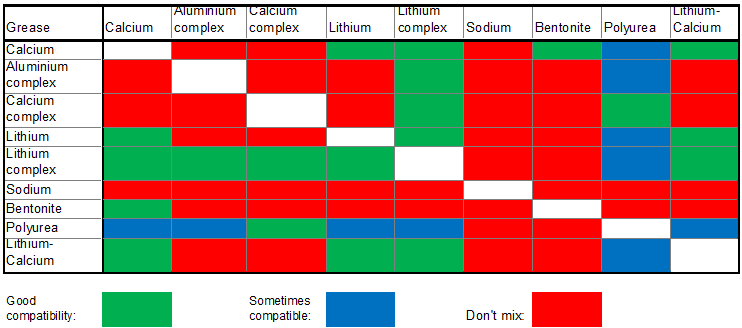
Compatibility of various types of greases
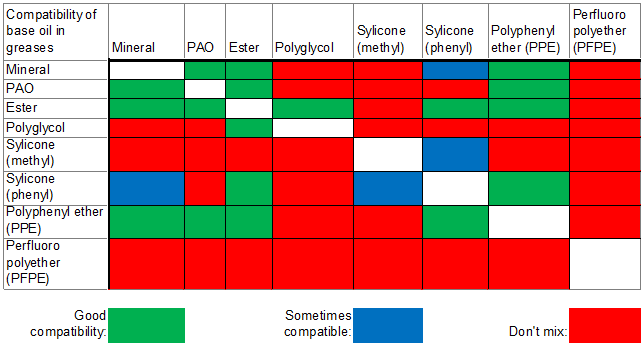
Compatibility of grease base oils
7. Recommendation of a bicycle bearings grease
Recommendations in this paragraph are author’s personal opinion based on knowledge and experience.
First some general guides will be given, then with more specific grease types.
- Optimal hardness for a bicycle bearing grease is NLGI 2, whichever grease type is chosen.
- General recommendation would be an ordinary lithium (soap based) grease. Available, cheap, with characteristics that satisfy all the criteria for this use. It hardly makes sense using anything else. Even those satisfying ISO water resistance standard with H level are not too expensive.
- If riding environment has lots of rains and/or sea water, good choice is calcium (soap based) grease (or “marine” grease). Available, cheap, with good water resistance. The only situations where this grease is not a very good choice are extreme heats (bike left for hours in over +35 °C summer sun), or riding in very low temperatures (below -15 °C).
- For a wide range of working temperatures (for -25 °C to hottest Africa heat), with very good water resistance attributes, but not too expensive – lithium complex grease with ISO water resistance level I. With, or without EP additives (doesn’t really matter). Still, this grease costs about double the price of ordinary lithium, or calcium based greases.
- For deep freezing temperatures, below -30 °C: choose either calcium, lithium, or calcium-lithium (mixed) grease, whether plain, or complex, with noted lowest working temperature of at least -40 °C (preferably -50°C).
- For coaster brake hubs (hub brakes) – good choice are greases that can withstand high temperatures (generated when braking). Lithium-complex soap based greases, or (if not sparing money, or they are already at hand) – lithium complex with molybdenum disulfide (MoS2).
Special types of “bicycle grease”, sold in many bike shops, or on-line rarely have a label noting standards it satisfies, often even don’t have fully and clearly listed ingredients. It’s up to the buyer to trust the manufacturer that it is the best grease for a bicycle. I’m yet to do lab testing of “special bicycle greases”, but when I do – they’d still have to be really, really exceptional to justify the price difference from a regular car-store sold lithium soap based grease, that fully satisfies all the criteria.
Author’s recommendation of greases from Amazon.com on-line shop (clicking on an image below opens Amazon affiliate link for on-line shopping). As an Amazon Associate I earn from qualifying purchases.
Note: listed greases are the ones I could find that are of good quality and with a world-wide distribution. Feel free to look for cheaper, locally available options. My 1st choice is local, Serbian made FAM FORPLEX 2 grease.
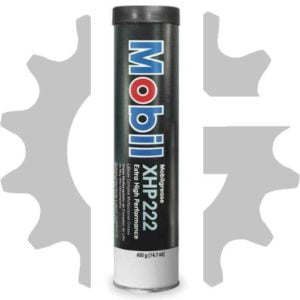
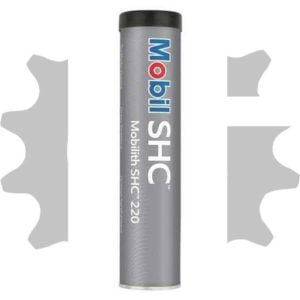
Update, December 2023:
Grease I’ve been using mostly over the past year is Motorex 2000 grease (also sold as “Motorex Bike grease”). Why? It is “officially” (by the manufacturer’s specifications) neutral towards plastic and many kinds of rubber (not to be used on DOT for brake rubber seals though). And it has a nice colour, but is mostly transparent, so I can easily see where and how much I’ve applied. 🙂 It is needlessly expensive for what I’m getting, but since I often work on other people’s bikes, and bikes are getting more and more plastic and carbon parts, I want to minimize any liability. This grease is calcium based.
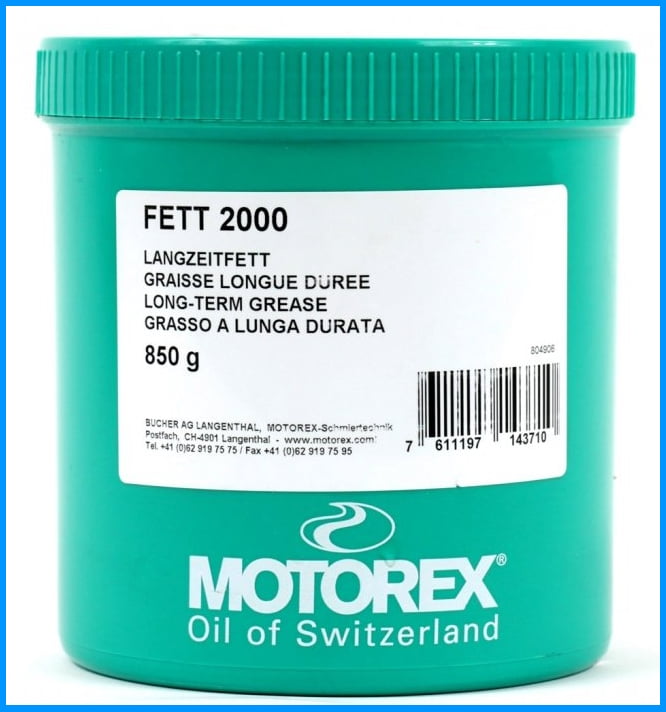
8. Sources
- https://motornaulja.blogspot.rs/
- http://www.maziva.org/izbor-maziva/mazive-masti/
- http://www.axelch.com/wordpress/wp-content/uploads/2014/12/WhitePaper-16.pdf
- https://bobistheoilguy.com/functions-of-grease/
- Rolling Bearing Analysis – Tedric A. Harris (Amazon affiliate link, I’ve used a borrowed, older, 4th edition)
Coauthor:
Stevan Dimitrijević (dr of metallurgical engineering)
Author of the greatest site (blog) in serbo-croatian language about motor oils and lubricants:
https://motornaulja.blogspot.rs/
Last updated:
Originally published:
Related post – Types and designs of bicycle bearings:

If you have any questions (or additions and corrections), please use the BikeGremlin forum – this is the forum topic related to this article:
https://www.bikegremlin.net/threads/bike-greases-questions.64/
The existing comments posted under this article (questions and answers) have been moved to this BikeGremlin forum thread:
https://www.bikegremlin.net/threads/bicycle-bearing-greases-explained-article-comments.105/

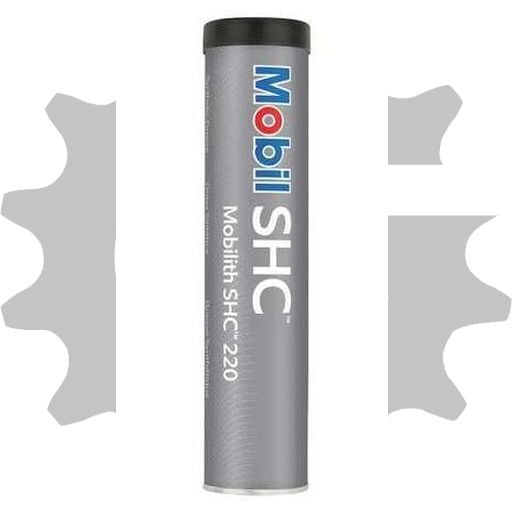
Serious levels of conjecture given here. I have to applaud the amount of conclusions made about which greases are suitable with zero science to support it.
– Why NLGI2? Why is that optimal? NLGI1 or 1.5 is perfectly fine for bicycle applications, NLGI2 is the primary grease to automotive applications.
– Lithium base is the best somehow? Shimano’s grease is calcium based, Park Tool’s grease is polyurea (which you really don’t cover), Buzzy’s Slick Honey is calcium based, Phil Wood is a marine grease variant… it seems your ‘ideal’ type of grease isn’t agreed by the industry at all.
– The working temperatures of literally all the greases you listed is perfectly fine for 95% of riders out there. Trying to make recommendations by a maybe 30*F change in ambient is not based on science.
– If you want to draw all these far fetched conclusions, back them up. You literally write off many perfectly fine greases with less than a sentence. With all the stuff you’d actually put down literally none of it is backed by science – just personal belief and conjecture.
– Zero data to show the actual properties of the actual greases to washout or corrosion inhibitance even though it is listed as a requirement.
– You mention your requirement stress test of 4 ball 1000 N weld test, only to never mention of show any test data of this.
– Tons of other issues due to absolute lack of real substance.
For all that is written (or possibly plagiarized again, who knows) it’s ironic how little actual science is here – it’s just your giving your opinion on certain types of grease with nothing to back it up. Fortunately a bicycle and its bearings is a low load and low thermal arena so literally anything will work, but basic NLGI 2 basic lithium grease being “optimal?” Please… It has one of the highest washouts of all the greases listed AND lithium based greases have one of the worst anti corrosion properties of all greases. Also consider that 1lb of grease will serve a bike owner their entire life so price in all honesty isn’t an issue so cheaping out here buying a $8 tub vs a $18 tub is really trivial. All in all another poor showing here showing you can copy and paste but don’t really understand.
NLGI 2 hardness grade has shown as the best in practice – both personal, and colleague mechanics. Softer greases don’t provide noticeably lower friction (when riding), while they leak out of the bearings more easily. Also NLGI 2 greases hold balls in place better than softer greases, which enables easier servicing.
To be technically more specific: a grease used for (high speed) automotive bearings applications needn’t be less thick for lower speed (bicycle) bearings. Quite the contrary. Besides, viscosity of used base oil plays a great role here as well. However, that is beyond the frame of a cycling blog post.
I never said lithium grease is the best. Optimal, considering both grease characteristics, as well as price, availability and compatibility with other greases – yes. In my opinion and experience.
Polyurea greases deserve their “place”, so I’ve added them – thanks for noting that.
Working temperatures were mentioned in grease descriptions and they are also noted on grease packages. Each will choose for themselves. Siberia and Africa riding conditions and temperatures surely differ. I don’t see a problem there.
Any recommendations you have to offer, or links to scientific researches/tests are more than welcome. Likewise, any correction of incorrect data are also welcome, in order to make the text better.
For water washout and most other properties/characteristic: ISO and DIN standards have strict scientifically based testing procedures that lubricants need to pass in order to fulfill the standard grades. Properties, such as water washout resistance are printed on the grease label, and are explained in detail in the post. Easily compared.
Minimal 4 ball weld test of 1000 N or better was a safe margin recommended by the post’s co-author, an expert on the subject, Stevan Dimitrijević. If you have relevant data that proves otherwise, please share it, I’d be more than happy to link it and correct the data in the post.
“NLGI 2 hardness grade has shown as the best in practice – both personal, and colleague mechanics. Softer greases don’t provide noticeably lower friction (when riding), while they leak out of the bearings more easily. Also NLGI 2 greases hold balls in place better than softer greases, which enables easier servicing.
To be technically more specific: a grease used for (high speed) automotive bearings applications needn’t be less thick for lower speed (bicycle) bearings. Quite the contrary. Besides, viscosity of used base oil plays a great role here as well. However, that is beyond the frame of a cycling blog post.”
How many bearings on a bicycle are held in by grease? Nearly all, except Shimano’s wheel bearings, are cartridge bearings thus don’t need the grease to “hold balls in place.” The whole NLGI 2 concept you’re trying to push really has no science backing it as in pure conjecture. Speed is only one reason that NLGI 2 greases are used in automotive but also the loads which are much in excess to bicycle needs.
“Working temperatures were mentioned in grease descriptions and they are also noted on grease packages. Each will choose for themselves. Siberia and Africa riding conditions and temperatures surely differ. I don’t see a problem there.”
Sorry but basing it purely on base oil composition isn’t the issue there. You can have a huge variance of working temperatures based on what the grease is made for. It’s not like all lithium greases are within X and Y working temperatures – far from it.
“Any recommendations you have to offer, or links to scientific researches/tests are more than welcome. Likewise, any correction of incorrect data are also welcome, in order to make the text better.”
That’s part of the problem, you have no data to refute. You only list what’s involved in determining NLGI and DIN ratings – the rest is pure conjecture. There’s absolutely no data (I’ve already provided this but you subsequently deleted the comment) in this entire article about how greases compare to one another in regard to wear and pitting, prevention of oxidation, washout, among any number of other scientific indicators. Just pure conjecture. You ever wonder why your white lithium grease looks a little brown when you pull it out even after short intervals? It’s because of oxidation, it’s not near the top of greases in it’s oxidation prevention properties. But since you never actually look into this data you’ll never understand greases in general.
“For water washout and most other properties/characteristic: ISO and DIN standards have strict scientifically based testing procedures that lubricants need to pass in order to fulfill the standard grades. Properties, such as water washout resistance are printed on the grease label, and are explained in detail in the post. Easily compared. ”
Easily compared yes, but you don’t do it once in the entire article. Not once do you actually compare the greases on any scientific metric. It’s a half sentence of base properties and then conjecture, absolutely zero knowledgeable comparison done. What’s the typical lithium grease washout when compared to marine grease, when compared to aluminum grease, when compared to polyurea? You have absolutely ZERO numbers to give comparison. thus this ENTIRE article is basically how NLGI and DIN is determined with your unsubstantiated opinion on a list of greases are. That’s it.
“Minimal 4 ball weld test of 1000 N or better was a safe margin recommended by the post’s co-author, an expert on the subject, Stevan Dimitrijević. If you have relevant data that proves otherwise, please share it, I’d be more than happy to link it and correct the data in the post.”
That’s the point. You NEVER show or indicate if ANY of these greases passes this arbitrary test. Not to mention which greases ended up protecting better than another or not just a random “industry standard” test that’s pass/fail that you just assume seemingly all passed? Again, you mention it as a requirement of your pick and then never mention the test again. It’ just further shows the absolute failing of this post and the subsequent failing of this post to prove or indicate anything beyond you just babbling your unsubstantiated opinion on greases.
Fact: Lithium grease is one of the cheapest greases on the market and is by far inferior to nearly all polyurea greases in all aspects besides price. Same deal with most aluminum based. And again, a 1lb tub of grease will last you 50 years so there’s literally no reason NOT to use it.
In addition, on a bicycle ultimate reduction in friction numbers isn’t all that important as we’re talking about percent of a percent here. Protection and longevity (washout and ability to stay) is likely most riders primary issue which would mean that they want to keep their bottom bracket and headsets clean of sweat, sports drinks and road grime and their wheels primarily free of water and grime… why in the world do the majority of your not “optimal” greases have much better washout properties? You’d think that would make you think, but no, you’ve been steadfast on basic lithium grease with literally (no, there’s no data in this entire article on comparing grease types) no data to support it besides your own very limited experience.
“How many bearings on a bicycle are held in by grease? Nearly all, except Shimano’s wheel bearings, are cartridge bearings thus don’t need the grease to “hold balls in place.” The whole NLGI 2 concept you’re trying to push really has no science backing it as in pure conjecture. Speed is only one reason that NLGI 2 greases are used in automotive but also the loads which are much in excess to bicycle needs.”
1) Not trying to push anything. Giving (correct) facts and experience – so each can choose for themselves. NLGI 1 will leak out of the bearings more quickly. Without giving measurable benefits of lower drag.
2) I think most bicycle wheels on the planet still use cup and cone system. 🙂 99% of the wheels used (and serviced) in my country are either Shimano, or cheaper versions of other manufacturers, with a cup and cone system (no scientific data for this either, you’ll have to take my word for it 🙂 ). Or call Serbian bike shops and ask how many cartridge bearing wheels are sold/serviced per year, not per month 🙂 . For cartridge bearings – yes, grease needn’t hold those in place, of course. There still is the problem of grease staying in place for longer.
3) Bottom line, for reasons noted in this reply, as well as in the post, NLGI 2 is “the sweet spot” of grease consistency in my opinion and experience. Those who think differently can choose for themselves. Since you mention science all the time (though this goes under engeneering IMO), I’m open to any comparative tests and results. My data comes from primitive non-scientific experience of hundreds of serviced bearings and seeing how they fare after a year (or two-three for “lazy” customers) has passed, as well as lots of books read and experts consulted. And I’ll repeat – if you see any errors, bad info, please correct – I’m grateful for any imput to improve the data.
“Sorry but basing it purely on base oil composition isn’t the issue there. You can have a huge variance of working temperatures based on what the grease is made for. It’s not like all lithium greases are within X and Y working temperatures – far from it. “
No, working range of each grease is (usually) written on the label, as well as within the ISO and DIN standards it complies with. Guide for deciphering those labels is given in the post.
“That’s part of the problem, you have no data to refute. You only list what’s involved in determining NLGI and DIN ratings – the rest is pure conjecture.”
That’s like saying: ‘you have no data on the expiry rate of this product, you only state the expiry rate printed on the package’.
What else is needed?
” There’s absolutely no data (I’ve already provided this but you subsequently deleted the comment) in this entire article about how greases compare to one another in regard to wear and pitting, prevention of oxidation, washout, among any number of other scientific indicators. Just pure conjecture. You ever wonder why your white lithium grease looks a little brown when you pull it out even after short intervals? It’s because of oxidation, it’s not near the top of greases in it’s oxidation prevention properties. But since you never actually look into this data you’ll never understand greases in general.”
As I will delete all the trolling comments in the future. I’m very liberal, but there is a line between criticsm and trolling. I’ve looked into those links and tables – yes, some greases are more easily washed off than the others.
Needed water washout resistance, unless a bicycle is ridden through over half a meter deep sea water is ISO E. Bicycle bearings are usually not sprayed with water under pressure, nor ridden throgh seas/rivers. You want better – look for any grease satisfying ISO I water washout resistance. There are lithium complex ones, calcium based ones, aluminium soap based ones (probably the best for sea water application, minding compatibility when re-greasing) etc. All the data is provided in the post.
“Easily compared yes, but you don’t do it once in the entire article. Not once do you actually compare the greases on any scientific metric.”
That is correct. I leave that to the reader – to compare data that are critical to them and choose for themselves. General recommendations for certain purpouses are given in chapter 7 and they’ve been proven good enough through decades of experience, including my personal.
A man cycling in Siberia will look for a grease with better low temperature working range, while a man riding in Africa will not bother with water washout resistance.
” It’s a half sentence of base properties and then conjecture, absolutely zero knowledgeable comparison done. What’s the typical lithium grease washout when compared to marine grease, when compared to aluminum grease, when compared to polyurea? You have absolutely ZERO numbers to give comparison. thus this ENTIRE article is basically how NLGI and DIN is determined with your unsubstantiated opinion on a list of greases are. That’s it”
Read the ISO labels on the particular grease you’re considering. General comparisons are given in table 1. But there are lithium (complex) soap based greases with better water washout resistance than calcium soap based ones – depending on the particular grease (model and manufacturer).
“That’s the point. You NEVER show or indicate if ANY of these greases passes this arbitrary test. Not to mention which greases ended up protecting better than another or not just a random “industry standard” test that’s pass/fail that you just assume seemingly all passed? Again, you mention it as a requirement of your pick and then never mention the test again. It’ just further shows the absolute failing of this post and the subsequent failing of this post to prove or indicate anything beyond you just babbling your unsubstantiated opinion on greases.”
I respect your opinion, but disagree. The answer would be the same as for previous paragraph. For a particular grease performance – look at the standards it complies with. For general comparison, look at the given tables, or research more.
Bicycle bearings don’t require any special grease IMO, as I’ve (tried to) explained in this post. Most any will do, while you can hardly go (measurably) better than a good quality lithium complex soap based grease with mineral base oil.
“Fact: Lithium grease is one of the cheapest greases on the market and is by far inferior to nearly all polyurea greases in all aspects besides price.”
Exactly. To put it plainly, if you want a Ferrari, you can buy a Ferrari. But I will give myself the liberty to say: it will not make your grocery shopping quicker, or easier. I have, however, given relevant data for reference and comparison.
” Same deal with most aluminum based. And again, a 1lb tub of grease will last you 50 years so there’s literally no reason NOT to use it.”
Except the price. There’s also no reason not to re-pack the bearings each day, except the price (paid in time in this case). Set your priorities and choose for yourself. But you’ll get very marginal (if any) benefits – both by repacking bearings daily and by using expensive greases.
Besides, open grease shelf life is about 5-7 years, closed new lid can be safe to use for about 10. After that, they might degrade – drying out, or base oil separating.
If you want a best possible, expensive grease for a piece of mind – go for it, by all means. It is an overkill, but each choose for themselves.
“In addition, on a bicycle ultimate reduction in friction numbers isn’t all that important as we’re talking about percent of a percent here. Protection and longevity (washout and ability to stay) is likely most riders primary issue which would mean that they want to keep their bottom bracket and headsets clean of sweat, sports drinks and road grime and their wheels primarily free of water and grime… why in the world do the majority of your not “optimal” greases have much better washout properties? You’d think that would make you think, but no, you’ve been steadfast on basic lithium grease with literally (no, there’s no data in this entire article on comparing grease types) no data to support it besides your own very limited experience.”
I’ll repeat: water washout and corrosion resistance depend on particular grease model. They are not carved in stone per the thickener type used.
Choose water washout resistance level of your liking. ISO E is good enough though. I’d also give myself the liberty to recommend annual cleaning and re-greasing of bearings as a better choice for longetivity, than using super-greases. Because of dirt and dust contamination. Cheapest grease changed annually will outperform the best grease changed once in a 2-5 years. Not because of grease degradation, but because of dirt contamination.
1) NLGI1 does not leak out of bearings faster especially with many of these are sealed bearings with covers. Please support WITH DATA.
2) Shimano is the primary wheel manufacturer that uses cup and cone. MOST others do not. Please update your own knowledge base. In addition Shimano bearings do not use grease to ‘hold them in place.’ So that argument is worthless again.
3) You have provided NO DATA AT ALL. NLGI2 is fine but is it ‘ideal’ or ‘optimal?’ No, because bicycles don’t need it. Please provide ONE study that shows NLGI2 is necessary for typical bicycle loads as thus far you haven’t provided ANY data so that would be a first.
4) Yes, the working range of the grease is written on the label of said grease. Duh. However, the working range ISN’T determined by grease type! All lithium grease are NOT ONE RANGE!
5) Bicycles that are ridden in acclimate weather receive constant water for HOURS of the ride. Having a grease with a 15% washout rating will NOT last months without servicing. In addition don’t address oxidation at all in your response showing you don’t take that into account.
6) You’ve still yet to prove (you using actual scientific studies…) why NLGI 2 AND having a basic lithium composition is the ‘optimal’
“Exactly. To put it plainly, if you want a Ferrari, you can buy a Ferrari. But I will give myself the liberty to say: it will not make your grocery shopping quicker, or easier. I have, however, given relevant data for reference and comparison.”
Garbage as we’re not talking about Ferrari’s here. We’re talking about $8 vs $16 grease that will last decades.
“Except the price. There’s also no reason not to re-pack the bearings each day, except the price (paid in time in this case). Set your priorities and choose for yourself. But you’ll get very marginal (if any) benefits – both by repacking bearings daily and by using expensive greases. ”
Who said you need to pack your bearings every day? Now you’re making up arguments to refute. Fact is lithium greases will wash out faster than marine, calcium, aluminum and numerous others. Fact is lithium grease has a poor oxidation prevention agents. Yet it’s still optimal or the best choice? Why? Again, prove WITH DATA not belligerent conjecture.
“I’ll repeat: water washout and corrosion resistance depend on particular grease model. They are not carved in stone per the thickener type used.”
Are you serious? THE ENTIRE ARTICLE the first thing you list in each type is water resistance. Literally. Yes there’s variation between each exact formula but no, lithium soap is lithium soap. It washes out.
Again, you take ZERO account for oxidation in your grease consideration. Again you’ve provided ZERO data to support your assertions. Again the cost of the greases becomes trivial considering how little you use and how long each tube will last but yet you let that over ride. Again you water down your opinion by saying it’s NOT about which is best or even “optimal” it’s whatever passed ISO E – which most manufacturers don’t even list! Here’s an ACTUAL DATA SHEET.
Your lithium greases from some of the largest manufacturers in the world:
http://content.valvoline.com/pdf/multipurpose_grease.pdf
http://lucasoil.com/pdf/TDS_White-Lithium-Grease.pdf
http://api.crcindustries.com/auto-services/get-pds/SL3360
Marine grease:
http://api.crcindustries.com/auto-services/get-pds/SL3120
Because it isn’t designed for prolonged water exposure, because it’s not designed for what you’re trying to make it claim, it’s NOT on the data sheets. There is no “ISO E” universal standard that all data sheets have so you’re looking for a statement that very few, if any, manufacturers claim.
Furthermore this entire series has been a showing of just how stubbornly ignorant you are toward actual science and actual data. Not a single thing you’ve brought up has been substantiated with scientific data.
Datasheets like this:
http://citeseerx.ist.psu.edu/viewdoc/download?doi=10.1.1.434.1778&rep=rep1&type=pdf
Actually show that aluminum is a better grease at typical bicycle temperatures. In addition data sheets like this show exactly how much variation there is in lithium greases and they’re wholly dependent on additive package to protect, polyurea is just a superior grease.
http://eb-cat.ds-navi.co.jp/enu/jtekt/tech/ej/img/no1003e/1003e_10.pdf
But that’s actual data from actual studies by actual science. Not your conjecture an ‘experience’ that seemingly trumps science. Maybe some of that will stick, maybe it won’t but if anything it shows the complete lack of actual science backing up your opinion. Again, fortunately a bike isn’t that complicated of a machine and doesn’t have strenuous demands. But the epic levels of stubbornness you exhibit in your beliefs goes to show why much of this blog is questionable at best.
“1) NLGI1 does not leak out of bearings faster especially with many of these are sealed bearings with covers. Please support WITH DATA.”
Don’t have links to test data – just like I don’t have data proving oil will leak out of the bearings faster. However, you needn’t take my word for it – do a test yourself on any cup and cone wheel bearing. Pack one with NLGI 1, the other with NLGI 2 and see how they turn up after 6 months.
Also, while you’re at it, see how packing the new balls goes with NLGI 1 grease. 🙂
“2) Shimano is the primary wheel manufacturer that uses cup and cone. MOST others do not. Please update your own knowledge base. In addition Shimano bearings do not use grease to ‘hold them in place.’ So that argument is worthless again.”
When packing the bearins, grease helps keep the balls in place.
As far as numbers go, I think most wheels on bikes worldwide today are not with cartridge bearings. Not yet.
In my coutry for sure – ratio is about 100 to 1, in favour of cup and cone.
“3) You have provided NO DATA AT ALL. NLGI2 is fine but is it ‘ideal’ or ‘optimal?’ No, because bicycles don’t need it. Please provide ONE study that shows NLGI2 is necessary for typical bicycle loads as thus far you haven’t provided ANY data so that would be a first.”
Already answered the logic behind my thinking. However, I have no “scientific” data proving that softer greases don’t stay in place as well as the harder ones. Except experience. Both first hand and other mechanics’.
“4) Yes, the working range of the grease is written on the label of said grease. Duh. However, the working range ISN’T determined by grease type! All lithium grease are NOT ONE RANGE!”
Never said that. Give rough general estimates – yes. Noting the reader to check for particular grease properties before buying/using it.
“5) Bicycles that are ridden in acclimate weather receive constant water for HOURS of the ride. Having a grease with a 15% washout rating will NOT last months without servicing. In addition don’t address oxidation at all in your response showing you don’t take that into account.”
This is not true. Bicycle bearings are not open with water flowing over them – not even the cup and cone. Not even in pouring rain. They all have at least some kind of dust seal. So they don’t get that much water and don’t need to be 100% waterproof.
“6) You’ve still yet to prove (you using actual scientific studies…) why NLGI 2 AND having a basic lithium composition is the ‘optimal’
Already explained. Not really sure what you are looking for. Standard trolling in my opinion.
“Garbage as we’re not talking about Ferrari’s here. We’re talking about $8 vs $16 grease that will last decades.
Who said you need to pack your bearings every day? Now you’re making up arguments to refute. Fact is lithium greases will wash out faster than marine, calcium, aluminum and numerous others. Fact is lithium grease has a poor oxidation prevention agents. Yet it’s still optimal or the best choice? Why? Again, prove WITH DATA not belligerent conjecture.”
My analogy was aimed at the overkill side of the comparison. You can pay double the price with questionable benefits (if any).
Pack bearings annually with lithium grease and they won’t rust.
Buy super-grease and re-lube less often – if here’s no dirt contamination, it will probably be fine. But I’d always recommend checking, cleaning and re-lubing annually.
“Are you serious? THE ENTIRE ARTICLE the first thing you list in each type is water resistance. Literally. Yes there’s variation between each exact formula but no, lithium soap is lithium soap. It washes out. ”
Yes, serious. For each soap (and non-soap) type I’ve given general properties.
I’ve also explained what the minimum requirements are, how to read and compare characteristics of a particular product.
“Again, you take ZERO account for oxidation in your grease consideration. Again you’ve provided ZERO data to support your assertions. Again the cost of the greases becomes trivial considering how little you use and how long each tube will last but yet you let that over ride. Again you water down your opinion by saying it’s NOT about which is best or even “optimal” it’s whatever passed ISO E – which most manufacturers don’t even list! Here’s an ACTUAL DATA SHEET.
Your lithium greases from some of the largest manufacturers in the world:
http://content.valvoline.com/pdf/multipurpose_grease.pdf
http://lucasoil.com/pdf/TDS_White-Lithium-Grease.pdf
http://api.crcindustries.com/auto-services/get-pds/SL3360
Marine grease:
http://api.crcindustries.com/auto-services/get-pds/SL3120
Because it isn’t designed for prolonged water exposure, because it’s not designed for what you’re trying to make it claim, it’s NOT on the data sheets. There is no “ISO E” universal standard that all data sheets have so you’re looking for a statement that very few, if any, manufacturers claim.”
If you don’t find ISO, or DIN labels, you can do several other things:
1. Trust what is written on the label, as a marketing slogan. However, there are lithium complex greases with better washout resistance than some “marine greases”. Same goes for other properties.
2. See what standards or other data producer provides, and see how they compare.
3. Judge by thickener and base oil types – general guides are provided and explained in this post – quite in detail.
“Furthermore this entire series has been a showing of just how stubbornly ignorant you are toward actual science and actual data. Not a single thing you’ve brought up has been substantiated with scientific data.”
When they talk about others, people say a lot about themselves too.
“Datasheets like this:
http://citeseerx.ist.psu.edu/viewdoc/download?doi=10.1.1.434.1778&rep=rep1&type=pdf
Actually show that aluminum is a better grease at typical bicycle temperatures. In addition data sheets like this show exactly how much variation there is in lithium greases and they’re wholly dependent on additive package to protect, polyurea is just a superior grease.
http://eb-cat.ds-navi.co.jp/enu/jtekt/tech/ej/img/no1003e/1003e_10.pdf
But that’s actual data from actual studies by actual science. Not your conjecture an ‘experience’ that seemingly trumps science. Maybe some of that will stick, maybe it won’t but if anything it shows the complete lack of actual science backing up your opinion. Again, fortunately a bike isn’t that complicated of a machine and doesn’t have strenuous demands. But the epic levels of stubbornness you exhibit in your beliefs goes to show why much of this blog is questionable at best.”
Very good, informative links.
My main “objections” to aluminium and polyurea greases are price and compatibility. Put plainly: for traffic safety, “the best” option is a tank, while an optimal recommendation most people would be well served with is just a plain old Volvo car.
Basically we can conclude that you have literally zero data comparing the greases to substantiate your opinion. This is what you’ve shown thus far.
1) Zero data actually showing NLGI 2 will leak out more than NLGI 1 in a sealed system. The “leaking” point is the dropping point you mention but seemingly fail to understand. The only argument here is NLGI 2 is easier to find.
2) Zero data or even practical knowledge (as you’ve never used it) showing that NLGI 1 or NLGI 1.5 won’t “hold” bearings well enough just to install into a cup and cone system.
3) Zero data or practical knowledge to understand that bearing shields are just that, shields. They are not water proof and even if just 10% of your rides are wet you’re talking dozens of hours of being exposed to water. In addition your bottom bracket and headset takes sweat and your drink of choice constantly. You purely ignore this for “good enough” when looking for the “optimal” grease. ZERO grease is “100% waterproof.”
4) No understanding that virtually all bottom bracket standards and headsets today use cartridge bearings and not open ball bearings so your argument of grease “holding” bearings is a very weak argument. In addition NLGI 1.5 and 1 will hold the balls just fine during assembly and basically only Shimano and Campagnolo use angular bearings in their wheels today.
5) Zero data actually comparing the different greases on any physical measurable level. Be it friction, be it pitting/wear, be it wash out, be it oxidation, be it load capacity, be it literally anything. The only metric you’ve measured them on is price – which is one of the absolute weakest metrics due to how little grease a bicycle uses. A single tire will cost more than you spend on grease during the next 30 years regardless of which type.
You say…
“Judge by thickener and base oil types – general guides are provided and explained in this post – quite in detail.”
Fact: Lithium grease without direct injection of rush inhibitor additives perform just as bad as sodium grease. Specific grease formulations matter and NOT this over generalized drivel purely based on thickener that you have posted here. It’s takes pure ignorance to NOT see that additive packages matter nearly as much as base thickener.
You say…
“My main “objections” to aluminium and polyurea greases are price and compatibility. Put plainly: for traffic safety, “the best” option is a tank, while an optimal recommendation most people would be well served with is just a plain old Volvo car.”
Idiotic comparison made by someone who has a very weak stance – really. Comparing two different types of grease that will cost pennies per application is the difference between a tank and an old Volvo? Anyone with half a brain will be able to tell you there’s a vast difference between a tank and Volvo. There’s not that much of a difference between greases but further showing you fundamental lack of understanding on this and many other subjects.
Bottom Line:
You don’t understand the science, you don’t understand the physical properties of each type, you don’t understand how much additives can change the base properties of each base, you over emphasize to a ludicrous degree (many we’re talking about less than a 20% difference in that) over price. Your best and only defense is conjecture with a healthy helping of “read the label” and “my [limited] experience.” The amount of things you say, “I have no proof” about is insane! You really don’t know what you’re talking about and to call this a research paper of any sort as it is an insult to anyone who’s worked in any scientific field or written a real paper. You have a very limited understanding with a very narrow viewpoint and I hope to anyone who reads your blog understands just how limited and questionable your opinions are and weigh them as such.
Allowing this, in my opinion, trolling post, just for objectivity sake. Because I think vanity is a dangerous thing, so deleting what I consider trolling might prevent me, in the future, from considering valid objections and arguments. I’ll go far enough to quote Friedrich Nietzsche:
“Beware that, when fighting monsters, you yourself do not become a monster… for when you gaze long into the abyss, the abyss gazes also into you.”
I’ve answered all your objections with arguments, now you’re just giving the same objections all over again. So I won’t bother arguing with a demagogue with lots of time on their hands. Life’s too short for that.
Cheers 🙂
You haven’t answered numerous questions unless your only answers are “not in my experience” and “read the label.” Considering that you likely haven’t had any direct or prolonged experience with the vast majority of these greases the only thing we can take away is “read the label.”
Further more this is long before you even consider that for headset bearings they generally have a range of motion of less than 20 degrees during a ride. You’d WANT a less viscous grease in the headset because of this short range of motion as the grease will have an easier time lubricating and protecting the bearings on this short arc when softer ala NLGI 1 or 1.5.
You fail to address cartridge bearings at all as your primary argument is to “hold” angular bearings in place. Bottom brackets, headsets and numerous wheels use cartridge bearings so your primary argument is moot for most users. You’ve never addressed this and will continue to sidestep the issue as you have no answer for your position. If you want to solely address open angular bearing cups for certain wheels, fine, do so. You don’t in this entire spiel.
When you claim this is a study to find the “optimal” grease with no science or practical knowledge on the subject and constantly fail to differentiate lithium and lithium complex greases (VERY different properties) and completely ignore additive packages it really goes to show your incredibly limited understanding on the subject and in addition, when shown other actual scientific data that refutes your claims you don’t have the open mindedness or understanding to even possibly consider revising your initial conclusion. This is NOT a trolling comment, this is a critical series of comments demanding data be provided to back up your recommendation. You’ve failed to do anything beyond being incredibly generalized summaries with no actual number substantiation.This isn’t an investigation, this isn’t science. This is just your conclusion based on what limited stuff you’ve used and no one will ever be able to refute your limited experience – because it is just that, drawing on only your own experience which doesn’t even include other types and formulations. Again, I hope people only read this and realize just how shallow and limited your “research” is and treat it for how much it’s actually worth.